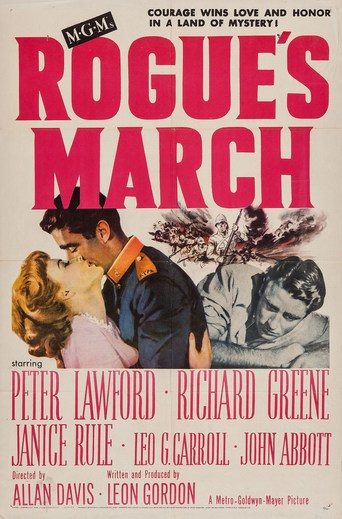

The last film on Peter Lawford's contract at Metro-Goldwyn-Mayer, director Allan Davis' "Rogue's March" amounts to a lightweight rehash of Zoltan Korda's classic "The Four Feathers" (1939) with John Clements. Despite an end credits thanks to India for allowing MGM to lense scenes in the Khyber Pass, most of this black & white epic was shot at the studio and at Vasquez Rocks in Southern California. Only the grain on the film betrays the fact that footage from the Errol Flynn adventure film "Kim" (1950) was used. A stellar cast, including Richard Greene, Janice Rule, Leo G. Carroll, Michael Pate, Sean McClory, Hayden Rorke, John Lupton, and Sidney Lawford, surround Peter Lawford. Mind you, it is routine from fade in to fadeout, but this 84-minute escapade depicts the court-martial of Captain Dion Lenbridge (Peter Lawford of "Sergeants 3") just as the Royal Midlands Fusiliers has been ordered to leave for action on the Afghan-Indian border. The military convict Lenbridge of selling secrets to the Russians, strip him of his rank, boot him out of the army, and prepare to try him in civil court. Lenbridge gives his minders the slip and re-enlists in another regiment. All of this comes at a particularly distressful time because Lenbridge had proposed marriage to Jane Wensley (Janice Rule of "Alvarez Kelly"). Although it qualifies as a potboiler, "Rogue's March" is a tolerably entertaining endeavor with a crisp Peter Lawford performance. Too bad it wasn't shot in color to take advantage of all those beautiful British uniforms.
... View MoreThis is our old friend the Bengal Lancers movie. Hero in disgrace, redeems himself by saving the honour of the regiment. Unlike most of the genre (The Charge of the Light Brigade, The Four Feathers, etc) this one is actually set in India or nearby for the most part. Peter Lawford is too weak for the lead; Richard Greene slightly too fruity, as always, for the second banana; and I don't know how Janice Rule got a gig as the English girlfriend, although she wears her best corset and a stunning Victorian ballgown trimmed with flowers at the bodice. Overall it's a fun example of the genre, and the battle scenes at the end, shot in the real Khyber Pass somehow, are alone worth the price of admission, giving you some idea of strategy & tactics, not just the usual hand to hand biffing.
... View MoreI saw Rogue's March this weekend, and it is indeed an unsung classic tale of The Great Game. Peter Lawford stars as a young Captain of the Royal Midland Fusiliers whose life and career are turned upside down as he is framed for treason. He makes his way to the Northwest Frontier to ultimately set things right. Some have branded this movie as a "poor man's Four Feathers, and I could understand someone calling this movie a British Branded. But there's more to this movie than that. While this film lacks much of the complexity of The Four Feathers, it redeems itself with its intrigue and action. The manner in which the Russians set our protagonist up is pretty interesting, and the battle scenes are superb. For someone like me, who thinks there are too few movies with pith helmets in the prop department, this was a treat.
... View MoreThere is a minor genre connected to war films of "proving" or "redeeming" films: Where the hero is branded coward or traitor and has to try to show he's been wronged. The best examples of these are the original FOUR FEATHERS (1939) and THE LIFE OF EMILE ZOLA (1938)[about the Dreyfus Case]. ROUGUES MARCH (1953) is a poor cousin of the other films, as it chronicles Peter Lawford's attempts to show he was framed for treason in India. The best moment in the film is when the actual traitor (John Abbott) is drowned by his Russian agent associates. The climax is when Lawford, after he has gotten his proof and presents it to his commanding officer is informed by that officer that the British Army knew the charges were false to begin with. That gives you a pretty good idea of the value of this film. Oh, as the commanding officer is Leo G. Carroll, perhaps you can see his performance here as a preperation for his U.S. spymaster handling Cary Grant in NORTH BY NORTHWEST (1959).
... View More